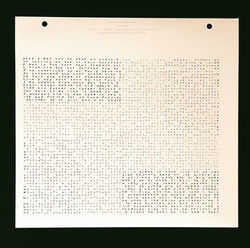textual workings
 Micro-text circa 1917 on abstract ground. Archival ink Acrylic canvas |  Micro-text inscribed in monumental shape circa 1917. Fine-point pen (0.05mm) on acrylic on linen canvas board |  An early attempt to utilise random numbers to direct textual progression. Light-fast ink on tracing paper |
|---|---|---|
 Text from a letter to the Times Newspaper in 1886 about the desperate plight of Joseph Merrick forever known now as 'The Elephant Man'. Fine-point pen (0.05mm) quatro page from stamp album |  My words I have composed about my abandonment in London in November 1953 in a telephone box on the Earls Court Road at the junction with Bolton Gardens. Fine-point pen (0.05mm) quatro page from stamp album |  Wise words from Elementary Clinical Practice first read by me as a preclinical Medical Student U Bristol 1972-77. Fine-point pen (0.05mm) quatro page from stamp album |
 On a Victorian palm-reading entitled 'Mother'. Fine-point pen (0.05mm) quatro page from stamp album |  A description of the MA Fine Art course at UCA Canterbury + the names of staff & my fellow students. Fine-point pen (0.05mm) quatro page from stamp album |  Detail from watercolour & pencil on watercolour paper |
 India ink on acrylic |  Photoshop layered images of pencil and ink writing & watercolour on image of floor tile |  pencil and ink on watercolour paper |
 Image of painting manipulated on snapseed |  image of painting manipulated on snapseed |  Layer image on photoshop (detail) |
 detail of manipulated image pencil and watercolour |
For 40 years, I have earned my living through words and writing as a physician. Like many doctors, my writing is close to indecipherable, almost asemic, at times.
I have always been interested in the ability of miniatures and small writing to capture viewers attention. Across the MA course I have noticed the power of the 'small' which seems just as well as apparently writing gets smaller in Parkinson's Disease which I've recently been diagnosed with!
Of all the words I have written, the most common will have been my signature on official forms such as medical records, prescriptions, death certificates and doctors' letters. Unsurprisingly perhaps, I have been inexorably drawn to textual art.
It is through text that learning, ideas, advice and feelings are imparted between humans. However, texts may sow discord through design or misunderstanding and decontextualisation. Equally, the issue may reside in the context of its reader, be they benign or malign.
It strikes me that trillions or more words have been, and will be, written. Most will be read by only a few people and most lost to posterity or only to be found by seekers with purpose or through serendipity.
Most written output will primarily serve its author alone and likely to have but a brief temporality. This is perhaps more likely nowadays given the daily tsunami of words around us.
With this in mind, I have returned to thinking of the 'mark' of the author/artist as the key to my work. For there was a time in all our lives when words were simply abstract meaningless shapes, before we learn their decipherment.
En route to such 'enlightenment', we will all have enjoyed the pleasure of making a 'mark'. It to this I turn in my work. To the place where a human physical mark is made on a man-made physical ground using a man-made physical substance.
My work explores the almost abstract 'asemic' nature of script and invites the viewer to search for an idiosyncratic 'meaning' through playful engagement with the 'mark'; not the encoded semiotic explication of the words.